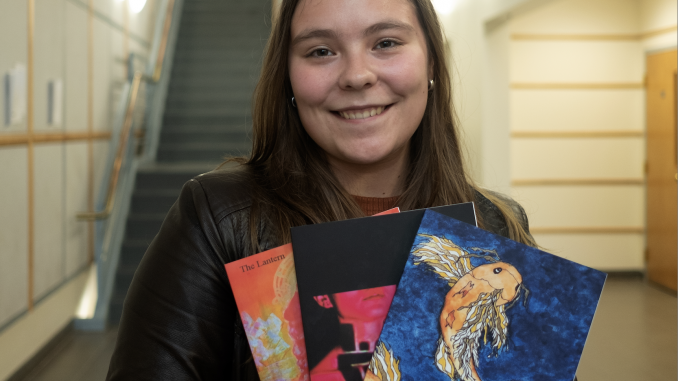
Colleen Murphy
comurphy2@ursinus.edu
“The Lantern” is in the early stages of producing its 89th edition this year, with October designated as “Lantern Submission Month.” Every year, Ursinus students can submit Non-fiction, Fiction, Poetry, Drama, and Visual Art pieces to be reviewed and chosen for publication by the staff of “The Lantern.” “The Grizzly” spoke to Nicole Kosar, this year’s editor, to get some insight about her role in the magazine, its impact on campus, and the behind-the-scenes of publishing.
Please talk about your goals for this year as editor of the Lantern. What exactly do you hope to accomplish? What do you want your impact to be on the magazine? What does the Lantern mean to you personally?
“The Lantern” means a lot to me — it’s the first place my work was ever published way back in freshman year! It kickstarted my love for the writing and editing world. So, this year, I’m here to give back. I want to continue this Ursinus tradition, as well as broaden the audience. We don’t just want English majors sending in their works — we want new perspectives and voices from math majors to dance minors. Ursinus’ creative body exists in more than one
What is the importance of having a literary magazine on campus? Why is “The Lantern” impactful? What does it contribute to Ursinus that other organizations might not?
Literary magazines are everywhere – from college campuses and small communities to corporate businesses and the backbone of publishing companies. It’s an expression of the population itself, and it showcases who we are. Authors and artists have the opportunity to produce something here on campus that feels significant. Sometimes the act of sharing your creation is transformative for both you and whoever is on the other end, flipping through the newest “Lantern.”
What is the process for picking and publishing pieces? What is the timeline like? What is your job specifically as editor, and how do you work with the section editors/readers?
Meet this year’s “Lantern” editorAs the editor, I’m responsible for staffing “The Lantern,” managing and communicating with all the departments, and act as a liaison between us and the publishing company who prints “The Lantern” for us. I’ll also end up with all the odd jobs – I’ve been running around campus this week making ads and flyers. I also work as a “super reader.” This means I read all the submissions myself, and talk or meet with the section editors about which pieces we liked. When it comes to rating the pieces, each section works differently, but for fiction, for example, we look at the plots, execution, prose, the feelings that hit us in the guts, and so much more. As far as the timeline goes, October is submissions month. Once November hits, our work starts. We read, judge, design, and send in our final copy by March and get ready for the April launch, which is when everybody will be able to grab their own copy for the 2019-2020 “Lantern!”
